
Izatha is a genus of moths of the family Oecophoridae. They are commonly known as lichen tuft moths. This genus is endemic to New Zealand.

Izatha attactella is a moth of the family Oecophoridae. This species is endemic to New Zealand, where it is known from both the North and South Islands as far south as mid-Canterbury. Larvae of this species feed on the soft inner surface of the bark of dead trees and shrubs. Adults have been recorded from September to December.

Izatha austera is a species of moth in the family Oecophoridae. It is endemic to New Zealand. The larvae of this species feed on dead wood by tunnelling into branches of its host species. The larvae matures from September and is on the wing in the months of December to January. The adult moth is variable in colouration but is seldom observed.

Izatha copiosella is a moth of the family Oecophoridae. It is endemic to New Zealand, where it is found on the south-eastern parts of the North Island and throughout the South Island except the West Coast. Larvae are found in dead wood and are likely to use kōwhai species as hosts. The adults are night fliers and are attracted to light. They are on the wing in January and February.

Izatha florida is a moth of the family Oecophoridae. It is endemic to New Zealand, where it is known from north-west Nelson.
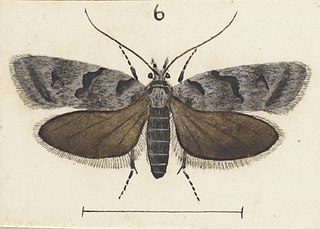
Izatha mira is a moth of the family Oecophoridae. It is endemic to New Zealand, where it is known from the western South Island, except north-west Nelson.
Izatha notodoxa is a moth of the family Oecophoridae. It is endemic to New Zealand, where it is known from the northern South Island.

Izatha katadiktya is a moth of the family Oecophoridae. It is endemic to New Zealand, where it is known from the eastern South Island, and probably Hawkes Bay.

Izatha acmonias is a moth of the family Oecophoridae. It is endemic to New Zealand, where it is known from the western South Island.
Izatha lignyarcha is a moth of the family Oecophoridae. It is endemic to New Zealand, where it is known only from higher altitudes on the North Island volcanoes, except for one specimen from Taupō and one from Masterton.

Izatha picarella is a moth of the family Oecophoridae. It is endemic to New Zealand, where it is known from the Nelson and Marlborough districts of the northern South Island.
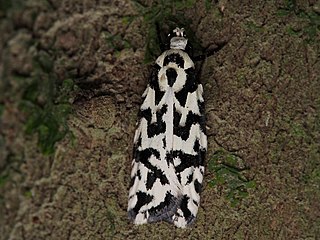
Izatha churtoni is a moth of the family Oecophoridae. It is endemic to New Zealand, where it is widespread in the North Island.
Izatha dulcior is a species of moth in the family Oecophoridae. It is endemic to New Zealand. This species is classified as "At Risk, Naturally Uncommon" by the Department of Conservation. I. dulcior is the first lepidoptera species described as endemic to the Poor Knights Islands.

Izatha mesoschista is a moth of the family Oecophoridae. It is endemic to New Zealand.
Izatha quinquejacula is a species of moth in the family Oecophoridae. It is endemic to New Zealand. This species is classified as "At Risk, Naturally Uncommon" by the Department of Conservation. It is only found on the Three Kings Islands.
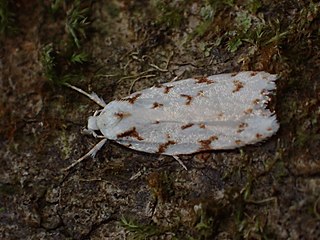
Izatha hudsoni is a species of moth in the family Oecophoridae. It is endemic to New Zealand. It is widespread throughout the North Island.

Izatha huttonii is a moth of the family Oecophoridae. It is endemic to New Zealand, where it is known from the Wellington district of the North Island, the South Island, and Stewart Island. Although similar in appearance to related species I. huttonii can be distinguished as it has a distinctive M-shaped mark on its forewings. The larvae feed on the dead wood of makomako and karamu. Adult moths have been collected from October to March.
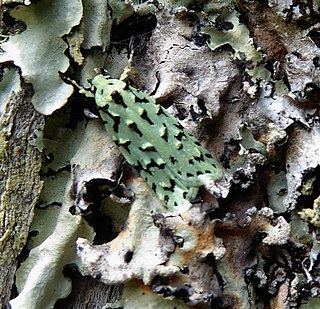
Izatha peroneanella, also known as the small lichen moth or the green lichen tuft, is a moth of the family Oecophoridae. It is endemic to New Zealand, where it is found throughout the North Island, other than the Aupouri Peninsula of Northland.

Izatha prasophyta is a moth of the family Oecophoridae. It is endemic to New Zealand, where it is known from the North Island, except Hawkes Bay or the Wairarapa. Larvae likely feed on rotting wood although larvae of this species have been reared on the fruiting body of the bracket fungus Bjerkandera adusta. Adults are on the wing from November to February.
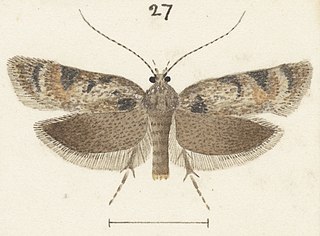
Izatha phaeoptila is a moth of the family Oecophoridae. It is endemic to New Zealand, where it is known from the North Island.
















